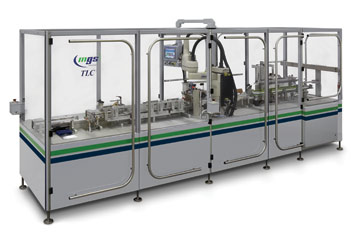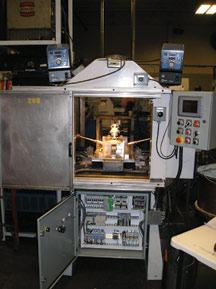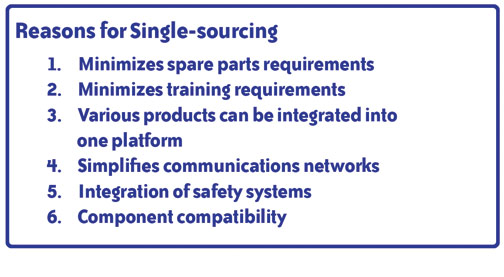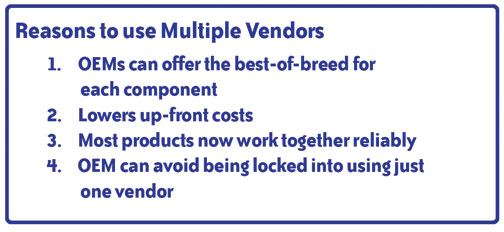Are your machine or robot control systems good enough, or should you make a change?
The machines and robots you build work well. You’ve kept up with periodic improvements. Most of your support calls are predictable. Why rock the boat?
As a machine or robot builder OEM, you understand the favorable economics of selling machines or robots for which your company has recovered its initial investment, particularly in the control system. Your margins are good, but are they as good as they could be with a control system upgrade?
Maturity Indicators
Most of the factors affecting decisions to upgrade can be categorized as performance related. However, other decision criteria include communication requirements, reliability, and safety.
Does the machine still do what it was designed to do as efficiently as it could to satisfy customers’ production requirements? “An automation system upgrade should increase Overall Equipment Effectiveness (OEE), often an important benefit for our customers,” says Mel Bahr, executive vice president at MGS Machine (www.mgsmachine.com), Maple Grove, Minnesota, in Control Design’s October 2010 cover story, “Time to Make a Change.”

MGS Machine builds top and horizontal-load cartoning machines as well as product feeding equipment. The image to the right shows how this work cell from MGS Machine feeds and opens auto-lock bottom, flat-blank, or glue-bottom cartons. The top is closed after a robot loads products into the carton. “Automation upgrades often make it easier to change products, crucial to our contract packaging clients, and increases in speed are also often realized,” adds Bahr in the cover story.
“Other reasons why we upgrade our automation systems periodically are improved HMIs and help screens, ability to control robots from a common machine control platform, improved servo performance and control, better data collection and tracking, automated data transfer to items like printers, and the need for vision systems and vision inspection,” concludes Bahr in the same Control Design story.
There are many reasons to upgrade automation systems says Joe Sebastian, senior systems engineer at Optimation, a system integrator servicing robot and machine builders along with other customers. “Safety, efficiency, increased availability of spare parts, easier or less maintenance required, improved connectivity to other systems, higher production capacities, less operator involvement and quicker setup or changeover times have all initiated automation upgrades,” he says in the cover story. His company has added very basic automation to machines and doubled their production speeds.
“Changeover times are also a huge consideration, as new machines can automate a great deal of the product changeover process, or even do it on the fly with it being initiated directly from an MES system,” Sebastian notes in the story. “Usually it is some combination of all of these factors that add up to an automation upgrade with an acceptable ROI.”
Reasons for Control Systems Upgrades
- Increased machine speed
- Increased safety
- Increased reliability
- Need for better, faster communications
- Better visualization fo machine operation
- Increased production capacity
- Quicker changeover times
- Increased machine marketability
Is ‘Old Reliable’ Still Reliable?
“If it ain’t broken, don’t fix it,” is a variation of an old maintenance and repair adage. Many machine control components continue to work well even as they approach obsolescence. Evaluating what to keep and what to replace often boils down to reliability, maintainability, and how the components in question affect machine performance.
Dan Jensen, senior automation engineer at Nelson Sales Corp (www.nelsonsales.com) in Muskego, Wisconsin, says in the same Control Design cover story, “The real question is, does the machine work well overall. In the case of older hydraulic systems, their on/off nature and abrupt directional or velocity changes often wear out parts and mean headaches for maintenance personnel.”
According to Jensen, replacing the old directional valve with a new hydraulic proportional servo valve/ motion controller combination can prolong the life of a machine due to reduced mechanical stress. Also, using better closed-loop controls can often enhance the reliability of some of the older hydraulic and mechanical components which are still functional for the application. “The machine builder can often cut costs by keeping the hydraulics and mechanicals, and replacing just the controls,” Jensen explains in the cover story.
Jensen did exactly that with a welding system he upgraded for a customer (Figure 2). His company used the existing hydraulic system, but it required a positioner that could stand up to weld spatter. “We added a linear magnetostrictive displacement transducer for positioning a slide that held the assembly being welded, a PLC, an operator screen, and a motion controller,” Jensen explains in the story.
A control system should probably be upgraded if it’s based on old relay logic, but what if solid-state control hardware is discontinued? The Internet makes supporting just about any legacy hardware or equipment possible, but is it desirable to rely on third-party support?
Obtaining support isn’t necessarily the primary reason for control system upgrades, as Jensen suggests. “Does the machine work well now, and will it stay working?” he asks in the Control Design story.
Do you remember floppy disk drives? “Does the computer software work with newer laptops, or do you have to keep an old laptop with special software on the shelf just in case?” Jensen asks in the story.
The machines may work and the designs may still be viable, but at what cost? If older components have high failure rates, maintaining or supporting a legacy control system can become costly. “Failure of obsolete components is generally unpredictable and almost always occurs at the least convenient time,” says Phil Gilkes in the Control Design cover story. Gilkes is director of product support at Intelligrated (www.intelligrated.com), a builder of material handling equipment in St. Louis, Missouri. “The downtime can result in significant costs to the end user.”
Additionally, controller ease-of-use can make selling machines a bit easier. “Traditionally, robot manufacturers used their own proprietary controller, which was complicated to program and had to be interfaced with other system components,” observes Gilkes in the cover story. “Now, complete robotic systems can be controlled by a single, powerful PLC. Customers are far more comfortable with PLC controls and tend to prefer systems and vendors that use them.”
Sometimes, there may be psychology at work in the use of the expression “new and improved.” But sometimes a new and improved control systems platform will better handle all the new tasks, requirements, and regulations that continue to surface in today’s manufacturing environments.
Playing it Safe
Safety continues to be a valid consideration when deciding if a control system upgrade is in order. In the Control Design cover story, Roger Rosinski, plant manager at All American Poly in Piscataway, New Jersey, says “Safety standards have become more stringent over the years, and older machines generally can be made much safer with an investment in controls.”
The European Machine Safety Directive (EN ISO 13849-1 or EN IEC 62061) is one of the new safety standards global machine and robot builders must satisfy. However, safety upgrades may not present value to an OEM for machines that already meet the standards required in their markets.
Jensen advocates simplicity. “A safety-networked architecture has to be large and duplicated to be cost-effective,” he notes in the cover story. As an example, he states, “Safety in a robot cell may be easier to do with discrete components such as a door interlock and a couple of E-stops.”
A systems integrator suggests an integrated approach. “An integrated automation and safety system is the accepted norm for most industries,” says Sebastian in the Control Design cover story. “If the existing system is proven safe, however, then safety is a hard sell by itself. Many old machines don’t have safety mechanisms built in, so safety controls can’t be added without major mechanical changes.”
Gilkes advises in the story, “The most compelling safety-related reason to upgrade is based on an assessment of the system itself to determine whether it meets with current standards, which can change as new legislation is developed.”
Safety relays and hard-wired safety interlocks may be employed in older safety systems to stop the equipment. However, if an emergency stop occurs, the control system could end up in an unknown state when these relays and interlocks cut power to critical components.
Unless compliance with standards is an issue, safety by itself is typically not a sufficient reason to upgrade a control system, according to system integrators and OEMs.
A Failure to Communicate?
A major advantage to upgrading your machine control platform is the ability to offer modern communications functionality such as Ethernet, fieldbuses, wireless, and Web access.
Michael Gurney, CEO at systems integrator Concept Systems (www.conceptsystemsinc.com) in Albany, Oregon, says in the Control Design cover story that communications is easier with newer control systems. “With the evolution of communication standards, there’s no reason that manufacturer to manufacturer communications can’t be done easily. If you’re considering a hardware manufacturer that’s difficult to interface to other automation components, you might want to reconsider using that supplier.”
 The ever-increasing need for manufacturing and equipment data is another significant factor to consider. For example, modern communications can allow machine-to-machine, HMI/ SCADA, Internet, and enterprise software connectivity. “In any automated environment, sharing data in real time is the key to efficient operation,” says Duane Grob in the story. Grob is the vice president of engineering at Optimation. “Without a means of sharing and communicating information with other subsystems, all actions are basically reactionary.”
The ever-increasing need for manufacturing and equipment data is another significant factor to consider. For example, modern communications can allow machine-to-machine, HMI/ SCADA, Internet, and enterprise software connectivity. “In any automated environment, sharing data in real time is the key to efficient operation,” says Duane Grob in the story. Grob is the vice president of engineering at Optimation. “Without a means of sharing and communicating information with other subsystems, all actions are basically reactionary.”
The image to the right shows how operators can now enter recipes on the touch screen of this welding machine due to automation system upgrades.
Better data means better information and better decisions. “Many older systems don’t integrate well with an overall automated environment,” Grob adds in the cover story. “Another related item is smart I/O communications for gathering more detailed device status. Some device information is simply inaccessible unless smart I/O platforms are incorporated into the overall system design. The data gathered from these devices can enable better decisions about maintenance, OEE, and system performance—as well as inform plant personnel on repairs needed to continue operations.”
Many control system components and platforms are available today with a plethora of communication protocol choices such as Ethernet and various fieldbuses. The demand for MES and ERP integration is growing among end users. Some OEMs are offering remote service and VPN functionality, which greatly reduce the demand on their support staff and lower their customers’ maintenance costs. If a control platform can’t keep up with data demands, it may be time for an upgrade.
Other Considerations
Rick de Jong, general manager, AEMK Systems, a robot manufacturer in Waterloo, Ontario, Canada comments in the cover story: “The most significant changes in machine and robot building are controls and flexibility. Flexibility means a machine or robot should be designed with product changes in mind. This means less fixed tooling, and a control platform that can be modified with minimal cost and time. Avoid the automation graveyard by ensuring that automated systems can not only be upgraded and modified, but also that the technology can be recycled into new applications.”
Sometimes, the decision comes down to money. “The overall cost of ownership needs to be considered,” advises Gurney in the story. “This includes maintenance costs, downtime costs, and the cost of not having something faster, more accurate, and/or more functional. These costs need to be considered over an acceptable ROI period.”
Where do systems integrators and machine builders stand on the question of whether to choose a single supplier, or work with multiple equipment and software vendors?
 In the cover story, de Jong says, “It’s wise to focus on a single vendor that integrates various products to one common platform. This reduces integration time and cost, provides faster service and support, reduces the training time, and eliminates the complexities of multiple vendor interfaces.”
In the cover story, de Jong says, “It’s wise to focus on a single vendor that integrates various products to one common platform. This reduces integration time and cost, provides faster service and support, reduces the training time, and eliminates the complexities of multiple vendor interfaces.”
Gurney also advocates vendor standardization. “We encourage companies to standardize on a single vendor for similar functions,” he advises in the Control Design story. “For example, companies should standardize on a PLC manufacturer, an HMI manufacturer, and a drive manufacturer. This minimizes spare parts and training requirements.”
Jensen offers a different perspective. “Using single-vendor systems usually means sacrificing capability for the sake of a name. Just because a manufacturer makes PLCs doesn’t mean their control architecture for servo control is worthwhile. Nowadays, everything worth using comes with an Ethernet interface and will communicate via various protocols, so being limited to one manufacturer isn’t necessary,” he said in the Control Design cover story.
 Procurement comes with significant inherent overhead. Buying from multiple vendors can increase costs that are not always easy to quantify. Using a single vendor can help reduce these costs. “From a purchasing perspective, the customer only has to deal with one vendor and thus can generally negotiate better discounts,” adds Gilkes in the story.
Procurement comes with significant inherent overhead. Buying from multiple vendors can increase costs that are not always easy to quantify. Using a single vendor can help reduce these costs. “From a purchasing perspective, the customer only has to deal with one vendor and thus can generally negotiate better discounts,” adds Gilkes in the story.
On the other hand, not upgrading is one way to avoid the single-source/ multiple vendor debate. “If a machine is old but otherwise performing well, it may be best to leave it unchanged, providing it continues to meet production and product life cycle requirements,” de Jong sums up in the cover story.
By Jack Smith
Originally Published: Dec 1, 2011

